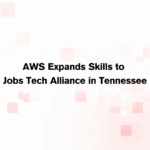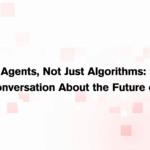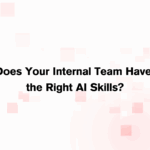
From Dot-Com Bubble to Agentic AI: A Conversation with Ryan Kettrey
In a laid-back but insight-packed conversation, Julie Simpson, Marketing Manager at Rōnin Consulting, sat down with founding owner Ryan Kettrey to talk shop. They covered everything from dot-com-era nostalgia to the challenges of modern Artificial Intelligence (AI) integration. What started as an impromptu recording between two colleagues quickly turned into a thoughtful reflection on how far tech has come and where it might be heading next.
Embracing technological shifts (and free snacks)
Ryan kicked things off with a trip down memory lane: his early days at GE in Nashville during the dot-com boom. When he got started, the company was constantly shifting gears. One day, he was coding in C++; the next day, everyone was told to become a Java web developer practically overnight.
It was chaotic and fast-paced, but it was where he learned some valuable lessons. His days at GE and this baptism by fire laid the foundation for his understanding of how tech constantly reinvents itself.
“I learned that switching technologies quickly and learning fast is just part of the job,” Ryan said. And that mindset continues to shape how Rōnin approaches emerging technologies today, especially in AI.
Is AI the new dot-com?
Julie posed the question: Is AI today what the dot-com era was in the late ’90s? And Ryan agreed…with caveats. While cloud computing was a significant shift, AI feels more akin to the dawn of the internet in terms of scale and impact.
The difference? AI is moving even faster and is infiltrating every industry, not just tech. From summarizing documents to enhancing developer workflows, AI isn’t just “nice to have.” It’s becoming essential. But like the dot-com boom, there’s also hype. Some execs are still chasing shiny objects without clear ROI. Ryan cautioned: “There’s already some centering happening. AI isn’t magic, and not every use case is mature yet.”
Ryan’s three flavors of AI adoption
Ryan broke down how Rōnin sees clients approaching AI in three broad categories:
1. AI-assisted development
Helping developers move faster with tools like GitHub Copilot and ChatGPT. It’s about shaving time off the repetitive stuff so devs can focus on the hard parts.
2. Vibe coding (yes, it’s a thing)
Think: writing apps using just plain English. Ideal for prototyping or proving out ideas. It’s exciting—but shallow for now. “You can build amazing UIs and be ready to demo your prototype by lunchtime, but these tools aren’t building a product with audit trails, governance, and deep integration. You still need an engineer to turn these demos into secure, scalable solutions,” says Ryan.
3. Embedded AI for workflow automation
This is where clients get serious. Think AI that summarizes client notes across platforms, auto-classifies documents, or helps teams process more cases in a day. These aren’t toy tools—they’re foundational enhancements that actually improve output.
What about legacy systems?
Julie asked a real-world question: What if your company still runs on-prem with legacy software? Can AI still work?
Ryan’s answer: Yes, but it’s trickier.
“You can absolutely use commercially hosted models via APIs, even with older systems,” he explained. “Running AI fully on-prem? Doable, but a much steeper hill to climb.” Translation: You don’t need a complete digital transformation to get started with AI, but the more flexible your architecture, the easier the integration.
The privacy panic (and how to calm it)
Naturally, concerns about data privacy and model training came up. Ryan explained that most clients worry about whether AI models will “remember“ their private data. Fortunately, Rōnin helps them understand how commercial models are trained and where safeguards exist. Their hands-on experience building small-scale models helps demystify the process and ease concerns.
Agentic AI and what’s to come
The episode wrapped up with laughter and a preview of what’s next: more on agentic AI. Ryan shared that his wife,an academic researcher, gets an earful about AI applications during their taco runs. “I think she probably tuned a lot of it out,“ he admitted. Julie nodded in solidarity on behalf of all non-technical partners everywhere.
As for the future? Julie summed it up best: “Next time, we’ll talk more about agentic AI, and hopefully get into how we will implement implementing it on our own site.”
Key takeaways
- AI is a major shift and it feels a lot like the early days of the internet.
- Not every AI idea is ROI-positive. Vet the use case, not just the hype.
- Legacy systems aren’t blockers. You can start small and scale smart.
- “Vibe coding“ is real, but don’t expect miracles (yet).
- Clients need clarity. Rōnin plays a key role in guiding AI choices, not just implementing tools.
Want more tech chats with dot-com flashbacks and AI metaphors? Subscribe to our YouTube channel and stay tuned for future episodes of whatever this turns into.





